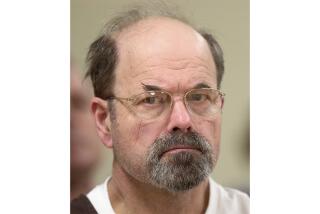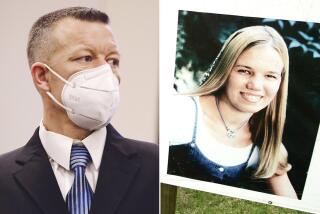Radar may yield clues on missing San Marino pair
Investigators are planning to use ground-penetrating radar in coming days to search for human remains and other evidence at a San Marino home that is at the center of a bizarre international mystery.
A young couple who lived at the home vanished in 1985, and nine years later, the remains of an unidentified man were found buried in the backyard. The cold case generated new interest this month after the Los Angeles County Sheriff’s Department named a Boston man, Clark Rockefeller, as a “person of interest” in the couple’s disappearance and suspected deaths.
Los Angeles County sheriff’s homicide detectives are bringing in a Denver geophysicist to examine the property where Jonathan and Linda Sohus lived, said Capt. Dave Smith, who leads the department’s homicide bureau.
Smith said the technology could be used later this week or early next week, and the examination may take several days. One reason for using radar is that investigators do not want to disturb the grounds, he said, where the new owners have been mobbed by national media.
“Hopefully we can see something that will allow us to concentrate on one particular area” to dig, Smith said.
Investigators last staged a massive excavation at the yard in 1994, after new residents uncovered bones while digging a backyard swimming pool. The bones, later identified as those of a small-framed man, had been separated into three parts and wrapped in plastic. Investigators also discovered bloodstains in a guesthouse on the property. While the remains have not been formally identified, detectives suspect they are those of Jonathan Sohus.
Smith said ground-penetrating radar has not been used on the yard before, probably because the technology did not exist in 1994. Experts say more recent advances in associated computer software, also used for medical imaging such as X-rays and CAT scans, have made it more popular.
Experts say investigators have successfully used ground-penetrating radar to unearth remains in other cold cases and homicide investigations.
California officials recently used the radar to scan -- unsuccessfully -- for human remains at the former home of Charles Manson and his followers at Barker Ranch in Panamint Springs, Calif.
Two years ago the ground-penetrating radar was also used in the unsuccessful search of a Michigan horse farm’s pastures for the remains of Jimmy Hoffa after the FBI received a tip that the missing Teamsters leader’s remains were buried there.
In 2002, authorities in Portland, Ore., used the radar to find the body of 13-year-old Ashley Powers, buried under a concrete slab in the backyard of a neighbor’s home. British authorities recently used the radar to locate the bodies of several children killed and buried near a child-care facility in the city of Jersey.
Lawrence B. Conyers, a University of Denver professor of anthropology, said ground radar can find long-buried bones several feet underground.
Conyers used the radar to aid investigators after the 1996 disappearance of Kristin Denise Smart, a Cal Poly San Luis Obispo student who vanished after attending another student’s birthday party. Smart’s body has never been found.
The radar, similar to weather radar or navigational radar used on ships, creates a picture of the underground landscape by bouncing electronic pulses off objects. Investigators can search a 50-square-meter area in a single day, Conyers said.
“What you get is really what you see if you dug a trench with a backhoe,” Conyers said, calling the radar images “a vertical slice of the ground.”
Conyers said the radar can find even long-buried objects. He used it to reveal the details of a buried ancient Roman temple in Petra, Jordan.
Once experts scan an area, they can use software to turn those images into subterranean maps. The ground radar Conyers used at the tar pits in 2005 was a lawn mower-like device wired to a flat-screen monitor 20 feet away that displayed the outline of objects up to six feet underground. Now, Conyers said, the device is the size of a lunch box, with software that can generate three-dimensional videos of underground images and antennas that emit electronic pulses capable of penetrating the floors of buildings.
“Concrete does not matter,” Conyers said. “In this case, it would be like digging up the yard. But thanks to this technology, you can see everything without any damage.”
But Conyers and other forensic experts cautioned that the technology is best used to find a shaft or grave where remains were buried, not remains themselves, and it cannot show whether any remains are human.
During the 1994 dig at the Sohus home, investigators found a second set of remains that they at first believed were human, but were later determined to be animal. Retired San Marino Police Det. Tricia Gough said the 1994 search was limited because some of the yard was covered in concrete.
Nicholas Herrmann, an assistant professor of anthropology at Mississippi State University, said that depending on the soil density in the yard, investigators could also use other underground imaging techniques, such as soil resistance, to locate places where the ground has been disturbed.
According to a map produced by the Natural Resources Conservation Service, much of Los Angeles County soil is highly suitable for ground-penetrating radar imaging.
Property records show the lot on Lorain Road is 13,924 square feet, including a 4,015-square-foot house that neighbors say was largely rebuilt after the Sohus couple disappeared.
The Sohus investigation drew national attention this month when detectives said Rockefeller, who was being held in Boston on unrelated kidnapping charges, was wanted for questioning in the disappearance and suspected killings of Linda, 28, and Jonathan Sohus, 26.
Authorities believe Rockefeller, then known as Christopher Chichester, lived in the Sohus’ guesthouse at the time the couple disappeared.
Rockefeller’s attorney confirmed in an interview with The Times that his client lived in the guesthouse. But he stressed that Rockefeller barely knew the couple and had nothing to do with their disappearance.
Rockefeller spoke publicly for the first time last week in interviews with the Boston Globe and NBC’s “Today” show.
The Globe reported that when Rockefeller was asked about his memories of John and Linda Sohus, he fell silent and smiled tightly, as his attorney told reporters to “move on to something else.”
--
molly.hennessy-fiske@latimes.com
richard.winton@latimes.com
More to Read
Sign up for Essential California
The most important California stories and recommendations in your inbox every morning.
You may occasionally receive promotional content from the Los Angeles Times.












